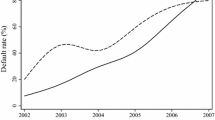Collateralized debt obligations (CDOs) are an innovation in the structured finance market that allow investors to invest in a diversified portfolio of assets at different risk attachment points to the portfolio. The basic concept behind a CDO is the redistribution of risk: some securities backed by a pool of assets in a CDO will be higher rated than the average rating of the portfolio and some will be lower rated.
Generally, CDOs take two forms, cash flow or synthetic. For a cash flow vehicle, investor capital is used directly to purchase the portfolio collateral and the cash generated by the portfolio is used to pay the investors in the CDO. Synthetic CDOs are usually transactions that involve an exchange of cash flow through a credit default swap or a total rate of return swap. The CDO basically sells credit protection on a reference portfolio and receives all cash generated on the portfolio. In these types of transaction, the full capital structure is exchanged and there is no correlation risk for the CDO issuer.
In this study, we are primarily interested in valuing (synthetic) single tranche CDO. It is very important to note that these products are exposed to correlation risk. In practice the CDO issuer sells protection on a portion of the capital structure on a reference portfolio of names. In exchange, he receives a running spread, usually paid quarterly, which value depends on the risk of the individual issuers in the reference portfolio and on a correlation hypothesis between those names. For liquid reference portfolios (indices) like Trac-X and iBoxx there exists now a liquid market for these single tranche CDOs and as a consequence for the correlation.
Access this chapter
Tax calculation will be finalised at checkout
Purchases are for personal use only
Preview
Unable to display preview. Download preview PDF.
Similar content being viewed by others
Bibliography
Antonov, A., Mechkov, S. and Misirpashaev, T. (2005). Analytical techniques for synthetic CDOs and credit default risk measures. Working Paper, NumeriX.
Andersen, L., Sidenius, J. and Basu, S. 2003. All hedges in one basket, Risk, 16:67-72.
Barbour A. D. and Eagleson, G. K. 1983. Poisson approximation for some statistics based on exchangeable trials, Advances in Applied Probability, 15(3):585-600.
Brasch, H.-J. (2004). A note on efficient pricing and risk calculation of credit basket products, Working paper, TD Securities.
Burtschell, X., Gregory, J. and Laurent J.-P. 2007. Beyond the Gaussian copula: stochastic and local correlation, Journal of Credit Risk, 3(1),31-62.
Chen, L.H.Y. 1975. Poisson approximation for dependent trials, Annals of Probability, 3:534-545.
Chen, L. H. Y. and Shao, Q.-M. 2001. A non-uniform Berry-Esseen bound via Stein’s method, Probability Theory and Related Fields, 120:236-254.
Chen, L. H. Y. and Shao, Q.-M. 2005. Stein’s method for normal approximation. An Introduction to Stein’s Method, volume 4,1-59, Lecture Notes Series, IMS, National University of Singapore, Singapore University Press and World Scientific Publishing.
Diener, F. and Diener, M. 2004. Asymptotics of price oscillations of a european Call option in a tree model, Mathematical Finance, 14(2):271-293.
El Karoui, N. and Jiao, Y. (2007). Stein’s method and zero bias transformation: application to large loss approximation and CDO pricing, Working paper, Ecole Polytechnique.
Goldstein, L. and Reinert, G. 1997. Stein’s method and the zero bias transformation with application to simple random sampling, Annals of Applied Probability, 7:935-952.
Hull, J. and White, A. (2004). Valuation of a CDO and an nth -to-default CDS without Monte Carlo simulation, Working paper, University of Toronto.
Martin, R., Thompson, K.and Browne, C. 2001. Taking to the saddle, Risk, June, 14(6).
Petrov, V. V. 1975. Sums of Independent Random Variables, Springer-Verlag.
Stein, C. 1972. A bound for the error in the normal approximation to the distribution of a sum of dependent random variables, Proc, Sixty Berkeley Symp. Math. Statist. Probab., 583-602. Univ. California Press, Berkeley.
Vasicek, O. (1991). Limiting loan loss probability distribution, Working paper, Moody’s KMV, 1991.
Author information
Authors and Affiliations
Editor information
Editors and Affiliations
Rights and permissions
Copyright information
© 2009 Springer Berlin Heidelberg
About this chapter
Cite this chapter
Karoui, N.E., Jiao, Y., Kurtz, D. (2009). Valuation and VaR Computation for CDOs Using Stein’s Method. In: Härdle, W.K., Hautsch, N., Overbeck, L. (eds) Applied Quantitative Finance. Springer, Berlin, Heidelberg. https://doi.org/10.1007/978-3-540-69179-2_8
Download citation
DOI: https://doi.org/10.1007/978-3-540-69179-2_8
Publisher Name: Springer, Berlin, Heidelberg
Print ISBN: 978-3-540-69177-8
Online ISBN: 978-3-540-69179-2
eBook Packages: Mathematics and StatisticsMathematics and Statistics (R0)




